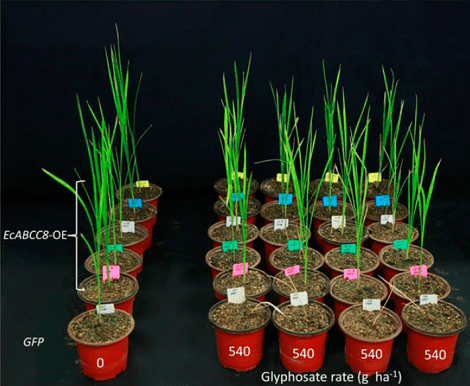
Lead researcher Dr Lang Pan, who was a former visiting PhD student at AHRI and is now Professor at Hunan Agricultural University, China, with AHRI researcher, Qin Yu. They were part of the team to discover the new glyphosate resistance mechanism.
IN a world-first breakthrough for research into herbicide resistance, a team of Australian and international scientists has discovered a new glyphosate resistance mechanism in plants that has similarities to cancer drug resistance in humans.
Researchers from the Australian Herbicide Resistance Initiative (AHRI) at the University of Western Australia, the Hunan Academy of Agricultural Science in China and Kiev in Ukraine have established that ABC transporter genes – which are present in nearly all living organisms – endow plants with resistance to the herbicide, glyphosate.
The ABC transporters behave in a similar way to how ABC transporters in humans can give resistance to anti-cancer drugs.
The discovery was made by scientists testing glyphosate-resistant awnless barnyard grass grown in the Kununurra-Ord River region of Western Australia.
They found the resistance was due to ABC transporters taking hold of the glyphosate molecules and pumping them out of the plants’ cells before they had time to have a toxic effect.
The work has gained international recognition with the scientific paper being accepted into the prestigious ‘Proceedings of the National Academy of Sciences’ (PNAS) journal in the United States.
Novel resistance mechanism
University of Western Australia emeritus professor and herbicide resistance expert, Stephen Powles, said this was the first time a plant ABC transporter had been found responsible for herbicide resistance.

UWA emeritus professor Stephen Powles.
“We consider it a very significant breakthrough for a couple of reasons. Firstly, it is a novel resistance mechanism that hasn’t been observed before for any cases of resistance,” he said.
“Secondly, the similarity between the way the transporters in human cancer cells can be resistant to certain anti-cancer drugs by their ability to pump the anti-cancer drugs out of the cancerous cells, and therefore endowing resistance. It is a very similar ABC transporter pumping glyphosate that gives glyphosate resistance.”
Professor Powles said while the discovery was still at the fundamental level, it was an important step in the pursuit of knowledge of how plants evolved resistance to herbicides such as glyphosate.
“One never knows what that might lead to,” he said.
“As I understand it with cancer, once the ABC transporters were identified as pumping drugs out of cancer cells with its obvious repercussions, that led to the development of more modern drugs that are used for cancer chemotherapy which often are chemically built to they can’t be pumped out of the cell by the ABC transporters.
“So, the first thing that will happen is that once researchers read the (PNAS) paper they will look for this resistance mechanism in glyphosate-resistant weeds. No doubt herbicide-discovery chemists will think about what that means for the design of herbicides.”
Combating herbicide resistance threat
Professor Powles said there was an urgent need for new, smarter chemicals and alternative technologies to combat the growing threat of glyphosate resistance.
“Globally, glyphosate resistance in the countries like the United States, Argentina and Brazil that grow glyphosate-resistant crops like corn and soybeans is a massive problem because of overuse of glyphosate,” he said.
“It is much less in Australia, but still a significant problem. For farmers in Australia and around the world, if we want glyphosate to keep working we have to work out how to show restraint with its use and how to have diversity because it is simply the world’s best herbicide.”

AHRI researchers and scientific paper authors Qin Yu and Heping Han.
RNA sequencing
In the latest issue of AHRI’s Insight publication, AHRI’s Peter Newman outlined how scientists made the discovery and explained in greater detail how ABC transporters allow plants to resist glyphosate.
He said the researchers started out using RNA sequencing and found two ABC transporter genes that were over expressed in the resistant population. Over expression simply means, as the name suggests, these genes are more common in the resistant plants resulting in plants that have more ABC transporters on their cell membrane.
Transgenic rice
The researchers then created transgenic rice that is identical to normal rice, apart from the over expression of these ABC genes. They then sprayed this rice with glyphosate and found that one of the ABC genes caused resistance. Specifically, it was the EcABCC8 transporter gene.
Figure 1 below shows the survival of this transgenic rice to glyphosate applied at 540 g ai/ha (on the right) compared to the control plants in the front row.

Figure 1: Transgenic rice with glyphosate applied at 540 g ai/ha (on the right) compared to the control plants in the front row.
As well as rice, the researchers also created transgenic maize and soybean that was resistant to glyphosate through over expression of the EcABCC8 transporter gene.
Burnt leaf tips
Moving glyphosate into the apoplast via these ABCC transporters leaves more glyphosate available for upward movement in the transpiration stream, accumulating glyphosate in the leaf tips. The transgenic rice with increased ABCC transporters where glyphosate was applied had burnt leaf tips compared to the control plants where whole leaf damage was observed.
Making plants more susceptible
In contrast to ABCC8 overexpression, the researchers then took the next step of using CRISPR/Cas9- mediated knockout to see if this enhances rice sensitivity to glyphosate. This is pretty tricky stuff. Essentially, the researchers used CRISPR technology to create a rice plant that has lower than normal ABCC8 transporters on the cell membrane and this increased the susceptibility to glyphosate. So, this technique further proves that ABCC8 is a player for glyphosate resistance.
What are ABC transporters?
They are proteins that are located on cell membranes. ABC transporters help move certain compounds across the cell membrane. Some compounds can simply diffuse across the cell membrane but others need help. This is called active transport. The ABC transporter recognises the compound (in this case glyphosate) and binds to it, then pushes it across the cell membrane with a “power stroke” energised by ATP. Plants have about 120 to 140 different ABC transporters divided into the families ABCA, ABCB, ABCC and so on with many sub families.

In reality, they look a little more like this.

Pumping glyphosate out of the cell
Glyphosate enters plant cells through diffusion and floats around in the cytoplasm. The cytoplasm is the ‘soup’ that all of the cell organelles are swimming around in. Glyphosate needs to get into the plastids to find its target enzyme, EPSPS. The pH of the cytoplasm is about 7 (neutral) and glyphosate gets trapped as it disassociates into anions so it is unable to simply diffuse out of the cell. This is why it takes active transport (e.g. from an ABCC transporter) to move it out of the cell. The ABCC transporters sit on the cell membrane and push the glyphosate into the apoplast. The apoplast is the space between the cells that is commonly used to transport liquids and gases. By pushing the glyphosate molecules into the apoplast the concentration of glyphosate in the cytoplasm is reduced and the effectiveness of the herbicide is reduced.

Great achievement
Mr Newman said AHRI was very excited to have the scientific paper accepted into the PNAS journal and to discover that a resistance mechanism in weeds has similarities to that of multi-drug resistance in cancer treatment.
“The research was made possible by an agreement with the Chinese government to host Chinese students at AHRI and we celebrate the success of student Lang Pan and others in this great achievement.”
Source: AHRI
The Grains Research and Development Corporation invests approximately $1 million in AHRI each year to ensure Australian grain growers have access to world class research in strategies to mitigate and manage herbicide resistance and weed management.
Grain Central: Get our free cropping news straight to your inbox – Click here

So what effect, if any, does this have on the glyphosate levels in the soil and surrounding area? And thus environmental impact,